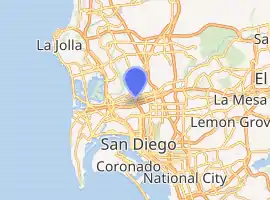Fashion Valley Mall
Fashion Valley (also referred to Fashion Valley Mall) is an upscale, open-air shopping mall in Mission Valley in San Diego, California. The shopping center has 1,720,533 sq ft (159,842.7 m2) of leasable floor area, making it the largest mall in San Diego and one of the largest in California. It is managed by the 50% owner Simon Property Group.
 Fashion Valley Mall | |

| |
| Location | San Diego, California, United States |
|---|---|
| Coordinates | 32.76725°N 117.16817°W |
| Address | 7007 Friars Rd. |
| Opening date | 1969 |
| Developer | The Hahn Company |
| Management | Simon Property Group |
| Owner | Simon Property Group (50%) / Lend Lease |
| No. of stores and services | 196[1] |
| No. of anchor tenants | 5 |
| Total retail floor area | 1,720,533 sq ft (159,842.7 m2)[1] |
| No. of floors | 2 |
| Public transit access | Fashion Valley Transit Center |
| Website | www |
History
Launch (1969)
Fashion Valley, developed by Ernest W. Hahn at a cost of $50 million, opened on October 12, 1969, (September 8 soft launch) on a 78-acre (32 ha) site part of which had held the baseball stadium Westgate Park. Aiming to be the leading shopping center in the San Diego region, it opened with 3 full-line department store anchors:[2]
- J.W. Robinson's - architects William Pereira and Associates
- Buffum's - architects Killingsworth, Brady and Associates
- The Broadway— designed by Charles Luckman and Associates and stated to have been the biggest Broadway opening of the 20 years up to that time. Broadway subsequently closed its Downtown San Diego store, the former Marston’s flagship.
Within a year, the center would add a two-story J. C. Penney (225,000 square feet (20,900 m2), opened Fall 1970), a Joseph Magnin specialty department store and a Woolworth discount store or five and dime (opened March 1970). At opening, the center had around a 1,000,000 square feet (93,000 m2) of gross leasable area, parking for 6,000 cars and a Spanish architectural theme, with quarry and red Spanish-style tile and a 50-foot (15 m)-high tower by sculptor Jerry Mahoney.[3]
Since its opening, the mall has undergone several expansions and changes.
1980s
The first major renovation was in August 1981 added Nordstrom and Neiman Marcus, establishing Fashion Valley as the fashion leader in the valley. The Joseph Magnin chain went out of business in 1984.
1990s
In 1991, Buffum's closed, and their location was reopened in 1992 by upscale specialty San Francisco department store I. Magnin. However, the upscale company eventually closed all stores in the mid-90s, and the Fashion Valley location was replaced by Saks Fifth Avenue in 1995. Robinson's became a Robinsons-May in 1993, while The Broadway was purchased by Macy's in 1996.
In October 1997, Gene Kemp led a $110 million renovation project, enlarging the Macy's, Nordstrom and Robinsons-May stores. It increased the mall size to 1,720,533 square feet (159,842.7 m2), 200 stores, and added 5 parking structures to accommodate 8,000 cars. In 2001, the owner of the property, Lend Lease Prime Property Fund, brought in Simon Property Group as half-owner and manager of the property.[4]
2000s
Due to the merger of May Department Stores and Federated Department Stores in 2006, Robinsons-May shuttered their store in March of that year, and the location was replaced by San Diego's first Bloomingdale's on November 18, 2006.[5]
2010s
Due to underperformance, Saks Fifth Avenue closed its Fashion Valley location on July 17, 2010.[6] The space was replaced with and still houses a Forever 21.
In 2019 Simon Malls announced another renovation, to add public spaces, landscaping, a broader selection of dining, outdoor "lounges" and water features.[7]
Mexican customer base
Fashion Valley is one of many shopping centers in the San Diego area which has customers from both Tijuana (a city of more than 2 million bordering the City of San Diego, 20 miles to the south of Fashion Valley), and visitors from the interior of Mexico (such as Mexico City), as an important part of its customer base. In 1977, 10% of transactions were with Mexican nationals.[8] In 2019 Simon Malls again reiterated the importance of its customers visiting from Mexico.[7]
Legal issues
Fashion Valley Mall was involved in a legal case involving the quasi-public nature of some private property. The printers union wanted to distribute leaflets in the mall encouraging patrons to boycott Robinsons-May, because Robinsons-May was an advertiser in the San Diego newspaper with which the printers union was negotiating. The court held that this activity was protected and allowed on the property, even though the action was contrary to the business interests of the targeted tenant.[9] The decision is based on article 1 section 2 of the California Constitution.
References
- "Fashion Valley". Simon Property Group, Inc. Retrieved 2011-02-10.
- "Formal Opening Set for Fashion Valley Stores". Los Angeles Times. August 31, 1969. p. 68.
- "36 Specialty Shops Open Now to Greet Public", San Diego Union-Tribune, October 12, 1969
- "Simon Property Group Purchases 50% Stake in San Diego's Fashion Valley Mall from Lend Lease's Prime Property Fund". Simon Property Group, Inc.
- "Federated Announces Strategic Decisions to Integrate May Company Acquisition; Company to Focus on Building the Macy's and Bloomingdale's Brands While Increasing Profitability". BusinessWire.
- "Saks Incorporated to close Saks Fifth Avenue store in San Diego, California". TheStreet.com.
- Horn, Jonathan (November 12, 2019). "Fashion Valley poised for multimillion dollar renovation". ABC 10 News San Diego.
- Murià Tuñón, Magalí (2010). "Enforcing boundaries : globalization, state power and the geography of cross- border consumption in Tijuana, Mexico" (PDF). Thesis, University of California, San Diego: 100.
- Fashion Valley Mall, LLC v. NLRB, 172 P. 3d 742 - Cal: Supreme Court 2007